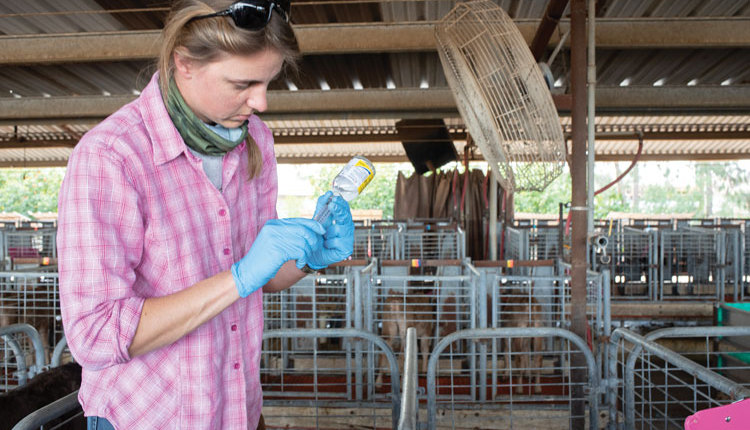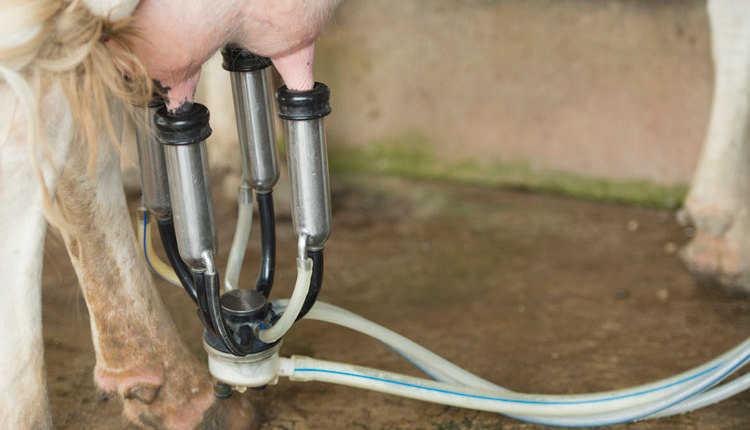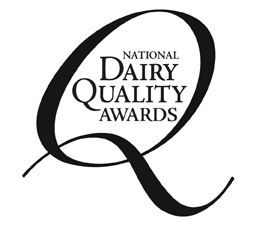
They produce the highest quality milk
These farms pair preventative practices with effective mastitis treatment. The six Platinum winners in this year's National Dairy Quality Awards competition work closely with their veterinarians to create sound protocols and outstanding results.The 2012 National Dairy Quality Award Platinum winners are again a group of exemplary milk quality professionals. The six farms recognized this year have both outstanding milk quality records and operations that strive for healthy and comfortable milking and dry cows at all times.
Applications came from nearly 200 farms this year. Just 51 made the final review by a panel of judges and were designated as either Silver, Gold or Platinum winners. The previous page lists all of this year's winners. Their nominators are also listed; those individuals deserve credit for bringing the applications forward.
Hoard's Dairyman is again privileged to co-sponsor the National Dairy Quality Awards with the National Mastitis Council. The program would not be possible without the sponsorship of GEA Farm Technologies, IBA/Ecolab, Elanco, QMI, Select Sires and the major sponsor Merial.
Now, let's learn from the 2012 Platinum winners.
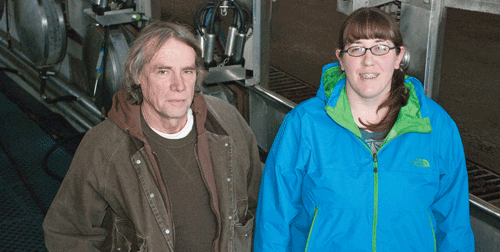
The 315 cows housed at Beattie Farms, Holton, Mich., are producing 25,500 pounds of milk each year, with an average somatic cell count of under 80,000. Don Beattie, owner of the operation, is pictured at the left with herdsperson Jennifer Saxton. Beattie Farms' standard plate count averaged just 1,080 during its application year. The farm has a double-16, rapid-exit, herringbone parlor. The cows lie on either free stalls bedded with sand or a bedded pack. Sand is added to the free stalls once each week, and the alleys are scraped twice daily. In the bedded-pack area, chopped straw is added twice per day. "They work very hard to make sure they are shipping the best quality milk possible, consistently throughout the year, "said nominator Ben Chapin of Michigan Milk Producers Association.
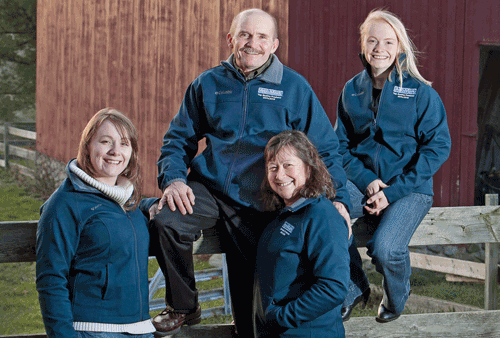
Tollgate Farm is owned by Jim and Karen Davenport, of Ancramdale, N.Y. The Davenports currently own 64 Holsteins and Ayrshires, along with 14 dry cows and young stock. Their Holsteins average 24,000 pounds of milk, with the Ayrshires at nearly 15,000 pounds per year. In 2011-2012, their somatic cell count reached only 67,000 in its worst month, averaging 46,750 for the year. The cows are in a tie stall barn bedded with kiln-dried pine sawdust. Nominator Ruth McCuin of Agri-Mark Cooperative said, "This farm has been Agri-Mark's top-quality producer for the last six years. Jim and Karen know that producing quality milk adds value to their milk check, benefits cow health and makes them better producers." Pictured are Jim and Karen (center), with daughters Laura (left) and Kristen (right).
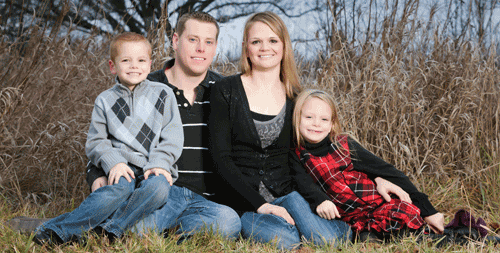
As repeat winners, the Dellar family maintains milk quality success in their herd with over 30,000 pounds (a 3,000-pound jump from last year's winning application) of production from 200 milking cows. Ryan and Charina Dellar are pictured with their children, Gavin and Carmen, near their Harrisville, Mich., facility. This year, Dellar Dairy lowered its somatic cell count from 53,000 to 43,333 as a 12-month average. Cattle are housed in a sand-bedded free stall barn where alleys are scraped three times per day - during each milking. The herd is milked in a double-10 parallel parlor. "Ryan and Charisa pay close attention to even the finest details while constantly researching and implementing innovative ideas," says nominator Preston Cole with Michigan Milk.
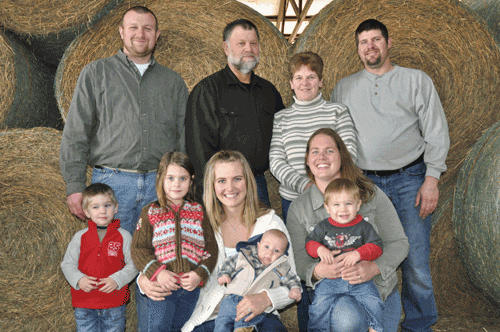
An 87,000 SCC put Circle K Farms in the 2012 National Dairy Quality Awards winners' circle. Their farm currently has 250 Holstein cows that are milked in a double-16 parallel parlor. In the parlor, milking technicians wear gloves and follow a written protocol, with five of the six milkers being family members. The Kartes' parlor records daily milk weights and uses conductivity to detect mastitis. Circle K is owned by Brad and Debby Kartes and achieves 24,000 pounds of milk per cow in West Branch, Mich. In addition to the low SCC, the farm's standard plate count averaged 1,170 in the 12-month period of the application. Pictured are (Back, L to R) Cole, Brad, Debbie and Keith. (Front, L to R) Tucker, Adysen, Lauren, holding Duke; Heather and Hayden Kartes.

Another familiar winner is the Michigan State University Dairy Field Lab, overseen by Bob Kreft. The Lansing, Mich., farm houses nearly 175 Holsteins and produces over 25,000 M. On this university dairy, students rotate through shifts in the farm's double-7 parlor. The herd's somatic cell count averaged 91,333 for the 12-month period, with a standard plate count of 1,417 during the same time. Pictured are (Front row, L to R) Dave Brady, MMPA Member representative (nominator); Todd Worden, Chelsey Clemens, Cora Watts, Shelbie Britton and Bruce Kurzhals. (Middle) Dr. Ted Ferris, Jacob Bontrager, Steven Openlander, Rob West, Randy Bontrager and Bob Story. (Back) Chad Geoit, Calvin Meyer, Jared Lyzenga, Michael Frazee, Jake Gillis, Fred Openlander and Bob Kreft, farm manager.

The site called "Farm 2" at True Farms, Perry, N.Y., is owned by Jeff, Brian and Glenn True, and it houses 380 Holstein and Brown Swiss cows which averages nearly 26,000 M and a 78,000 SCC. Pictured are (Front, L to R) Trenten and Taryn True. (Back) Andrea, Brad, Stacia, Tucker, Jeff, Chris; Noemi and Zeferina Garcia; Diane and Brian True. They milk in a double-10 parallel parlor, and cows lie on sand-bedded free stalls with bedding added twice each week. Farm 2 has rubber belting in the entire feed alley and pushes up feed 12 times per day. Donna Walker, nominator from Dairylea Cooperative, says that, "True Farms does an exceptional job balancing the production of high-quality milk. They thoughtfully create protocols and follow them for consistent results."
What is your milking procedure?
Beattie: We have a written milking procedure, and milkers always wear gloves. We predip, strip out foremilk, dry teats with cloth towels, attach milking units and postdip.
Davenport: We also have a written milking procedure, and our milkers always wear gloves. We strip out foremilk (plastic strip cup/black screen), predip with Nolvasan teat dip, dry teats with single-service white towels, attach milking units 60 seconds after forestripping and postdip (same as predip with nonreturn teat dippers). We ensure cows always lie back down in clean, dry bedding.
Dellar: We dry wipe teats with microfiber towels to remove sand, dip teats with foam, strip out foremilk and massage dip into teat ends, redip, dry teats with microfiber towels, attach milking units and postdip. There is a written milking procedure, and milkers wear gloves for every milking.
Kartes: We have a written milking procedure, and milkers wear gloves 100 percent of the time. We wipe sand and debris off teats with a dry hand, strip out foremilk, predip with 1 percent iodine, dry teats with cloth towels, attach milking units, hand strip after milking if a quarter looks abnormal and postdip with 1 percent iodine.
MSU: We spray a predip (massaging it on the teats and teat ends), strip out foremilk, dry teats with individual cloth towels, attach milking units and postdip. We have a written milking procedure, and milkers wear gloves all the time.
True: We have a written milking procedure. Milkers wear gloves and change them with every pen change. We predip, strip out foremilk, predip again, dry teats with cloth towels, attach milking units and postdip.
How do you maintain healthy teat ends?
Beattie: We make sure teats are clean and dry and that the udder is well stimulated at the time of unit attachment and maintain vacuum levels.
Davenport: We look for a 60/40 pulsation ratio, proper cluster positioning, use IBA Prosquare inflations and allow the machine to be removed only after the vacuum is completely depleted.
Dellar: We utilize cows' full oxytocin levels by attaching units 60 to 90 seconds after stimulation, monitor vacuum levels and make frequent inflation changes. We also let teat dip dry in the winter before letting cows go outside.
Kartes: Milkers are trained to wipe sand off and prestrip before predipping. After predipping, we wipe each teat and teat end at least three times to provide good stimulation and thoroughly dry them. Then we wait 60 to 90 seconds for good milk letdown before attaching the milking unit. We also use silicone liners, changed regularly, and check pulsation rates regularly. We use cloth towels.
MSU: We work closely with our milking equipment dealer to insure equipment is functioning properly and use good teat dips.
True: We like an emollient in predip and postdip, use auto take-offs, routinely monitor vacuum pressure, do frequent liner changes and switch to our winter dip in October.
How do you keep cows comfortable?
Beattie: Alleys are scraped twice daily and stalls are raked once a day. Fresh sand is put in once per week. Bedded-pack cows are bedded twice a day with chopped straw. Waterers are cleaned every other day except in summer months when they get cleaned daily.
Davenport: We use kiln-dried pine sawdust at 0.5 cubic foot per tie stall per day with 2 ounces of hydrated lime on foam mattresses. Manure is scraped by hand at least six times per day, continuously during milking. We open our barn and turn on overhead fans during warm weather. Our barn is closed with eave inlets and a thermostatically controlled fan when below 30°F.
Dellar: Sand-bedded free stalls are raked every day, and manure is kicked out at every milking. Alleys are scraped three times a day at each milking. New bedding is put in every five to six days. Waterers are cleaned weekly. We also use tarps/side curtains and fans to accommodate weather conditions.
Kartes: We have a four-row head-to-head free stall barn with a feed alley through the center. We run a one cow per stall capacity at the max, so overcrowding is never an issue. Our free stalls are bedded with beach sand every two weeks. Our barn also has 14-foot sidewalls with curtains all the way from top to bottom for optimum ventilation. The barn is completely scraped twice daily at milking times, and all personnel carry a sand rake when bringing cows to the parlor. Also, any sand is leveled flat in stalls at this time.
MSU: Gel mats and pasture mats are scraped and rebedded twice a day. Comfortable bedding includes putting down hydrated lime, then kiln dried sawdust.
True: Sand-bedded stalls are groomed each day and get more sand twice a week. At each milking, we clean out the backs of the stalls and scrape alleys. We also monitor neck rails and free stalls to make sure the measurements are correct.
Each pen has its own sprinklers, plus the holding area has a soaker. The pens and holding area have 60-inch fans which enhance the natural ventilation. We have curtains for inclement weather. We use foot baths on the exit alley of the parlor and rubber belting in all feed alleys. Feed pushup occurs 12 times per day.
How do you detect subclinical cases?
Beattie: DHI hot sheet and CMT.
Davenport: CMT screening or DHI high SCC cow list.
Dellar: CMT paddle and PortaSCC strips along with our DHI hot sheet.
Kartes: We CMT paddle all fresh and dry-off cows. Also watch milk weights and conductivity reports daily.
MSU: DHI hot sheet, DeLaval cell counter and CMT paddle.
True: Monthly DHI SCC testing and CMT testing on suspicious quarters.
How do you detect clinical mastitis?
Beattie: Forestripping, udder abnormalities, cow behavior and CMT.
Davenport: Strip cup, backed up with CMT.
Dellar: Prestripping in addition to observing udders and cow appearance.
Kartes: Prestrip every cow, visually check every cow after milking for abnormal quarters.
MSU: Stripping as part of milking procedures.
True: Forestripping, low production, CMT testing and watch for abnormal udder appearance.
Describe your fresh-cow monitoring.
Beattie: We monitor each cow closely by checking milk, body temperature and udder swelling. We use the CMT on third milking and treat any positive quarters with Spectramast LC.
Davenport: All fresh cows are CMTed, and prefresh cows are checked visibly for swollen quarters or teat damage. For any high counts not attributed to colostrum, we culture and use the quarter milker until results are obtained. Since it is often no growth, any more clinical signs are cultured but treated with an over-the-counter broad spectrum lactating remedy.
Dellar: DHI monthly hot sheet, CMT paddle and PortaSCC strips. We CMT paddle each cow on the fifth milking. If the CMT is good, we pull individual quarter samples and run the PortaSCC on each quarter. When all quarters are below 50,000, the cow's milk enters the tank. If the CMT is bad, a sample is taken and a culture is performed on farm.
Kartes: We milk all fresh cows in the bucket for six days, then we CMT paddle all quarters. We have to get a negative result in all quarters before that cow's milk goes in the bulk tank. We also heavily prestrip and watch daily milk weights and conductivity levels. If we get a positive, we will on-farm culture that cow and treat her with a lactation therapy according to the pathogen.
MSU: After a negative Delvo test for antibiotics, we check SCC with a DeLaval cell counter.
True: We use visual monitoring of colostrum and forestripping at freshening. Otherwise, we use monthly SCC testing by DHI, forestripping to monitor for mastitis and vet-established mastitis treatment protocols. We do routine bulk tank culturing for mastitis pathogens. Treated cows are milked in a separate flat parlor.
What steps do you take at dry-off?
Beattie: Cows are taken off TMR, fed dry hay and milked once a day for five to seven days to lower their milk production, then at dry-off day, they are administered with Albadry Plus, then Orbeseal. Cows are in a bedded-pack barn that is sawdust bedded. They have access to a dirt lot for exercise. The barn is bedded two times per week and cleaned once a week. Two to three weeks prior to calving, the cows get moved to a comfortable straw pack barn.
Davenport: Dry cows are isolated from the milking string and fed free-choice 58 NDF grass hay and water. We milk them once daily until production is less than 20 pounds per day. To dry teat, we swab each teat end with an alcohol pad and simultaneously inject one tube of Quartermaster while massaging the quarter. That is followed with a tube of Orbeseal, postdip and a shot of Triangle 10.
Cows have access to grass pasture for all but the worst weather. When inside, we use 56 to 58 NDF grass haylage and minerals with refusals to 30-day prefresh cows and heifers.
Dellar: A Spectramast DC tube is used in each quarter followed by Orbeseal teat sealant. J-5 vaccine is given at dry-off and one to two weeks before calving. We also monitor the last DHIA score.
Close-up cows are housed in sand-bedded free stalls, while dry cows are housed on sawdust-bedded free stalls kicked out and raked daily. Alleys are scraped daily.
Kartes: We CMT paddle all cows to check for subclinical mastitis. If no signs, we dry treat all quarters with Tomorrow, vaccinate with J-VAC and move her to the dry pen. If a cow has subclinical signs, we will treat with appropriate lactating treatment until clear, then dry off with dry treatment and J-VAC vaccine, then move to dry pen.
Dry cows are housed in sand-based free stalls, bedded every two weeks and leveled daily.
MSU: We treat with Quartermaster and Orbeseal, then apply T-Hexx dip and vaccinate with J-5.
True: We milk the cow out, dry treat with Tomorrow and Orbeseal and then use T-Hexx barrier dip. Dry cows go to a sand-bedded free stall barn. They are also vaccinated with J-5 at prefresh. Sand bedding is applied weekly, stalls groomed daily and alleys are cleaned two times a day. The barn has 60-inch fans to optimize air quality, rubber belting on the feed alleys and cows see frequent feed pushup.
Describe your treatment procedures.
For mild cases:
Beattie: We treat with Spectramast LC intramammary (IMM) and segregate the treated cow.
Davenport: Quarter milk until culture results come back. Then we treat in the quarter or allow to self cure (no visible growth samples).
Dellar: We take a sterile sample, run the culture and determine SCC using a PortaSCC strip. We read the culture result and decide to treat based on the organism found, or not to treat and let her self cure. If treated, Spectramast LC is most commonly used once a day for eight days.
Kartes: After a culture, gram-positive cows are treated with Today for four consecutive milkings inserted IMM. Gram-negative cows are milked in a bucket until clear in CMT paddle/or dry off quarter or sell.
MSU: We use Spectramast LC IMM, Polyflex intramuscular.
True: Oxytocin at milkout, then five days of one- time-a-day Spectramast LC.
For moderate cases:
Beattie: We treat the quarter with Spectramast LC, segregate, and give Polyflex intramuscular and aspirin.
Davenport: We culture, give an IV of Banamine over the counter with Spectramast IMM. We use Today if culture indicates a bug that isn't Spectramast's forte.
Dellar: We take a sterile sample and give four aspirin boluses for swelling. Then, we apply Udder Comfort and treat at first sign and after positive CMT test.
Kartes: Same as mild with the addition of four aspirin boluses twice a day for two days and rub on udder mint cream after milkout.
MSU: Same as mild cases.
True: Same as mild cases with four aspirin once a day for five days, and Udder Comfort.
For severe cases:
Beattie: We treat quarter with Spectramast LC (IMM), segregate, and give Banamine and hypertonic saline (through IV) and Polyflex (intramuscular).
Davenport: For those rare, severe cases, we use two hypersaline IVs, a Banamine IV, then a milk culture. We use Spectramast IM multiple times unless the culture proves a bug is not susceptible, then we use Today. We would milk her with oxytocin.
Dellar: We do not have systemic mastitis cows.
Kartes: Same as mild and moderate plus two bottles of dextrose twice daily until she improves. We also use 60cc of oxytetracycline intravenously one time.
MSU: Same as mild and moderate, plus a flunixin IV, hypertonic saline IV and drench with YMCP that contains yeast, magnesium, calcium and potassium and about 10 gallons of water.
True: We use oxytocin and Spectramast LC at milkout. We'll use Banamine IV for three days, use Naxcel intramuscular four days, 2 liters hypertonic saline IV, drench with 10 gallons drench mix (YMCP mix) and monitor temperature.
How do you track treated cows?
Beattie: Ours are double banded with red velcro leg bands. Records are kept in an on-farm notebook containing cow ID, date treated and treatment given. We use PC Dart.
Davenport: A leg band is on the rear leg of the side you milk from and note to next milker. Records are kept on the individual paper cow record page.
Dellar: Red rubber leg bands on both legs, red spray paint on legs and udder. Parlor notebooks and calendars. All treatments are entered into computer as well. Notebooks are kept, and computer records are permanent.
Kartes: With fluorescent orange ribbon and binder twine around pasterns. Also, our milking parlor alarms us if we try to attach a milking unit to a treated cow. All treated cows are marked on a daily calendar in the parlor with the treatment and what milking it needs to be administered. All treatments are kept on Herdmetrix dairy software program, and a backup is made daily.
MSU: With a plastic yellow leg band, daily log book, Dairy Comp 305 and instructions posted in the parlor pit.
True: They are banded and separated out into the hospital string and milked in a separate flat parlor. Every cow has a treatment log. Plus, the cow is entered into Dairy Comp 305. We also have a daily treatment book. Every event is entered into the cow's Dairy Comp record, plus the treatment log.







